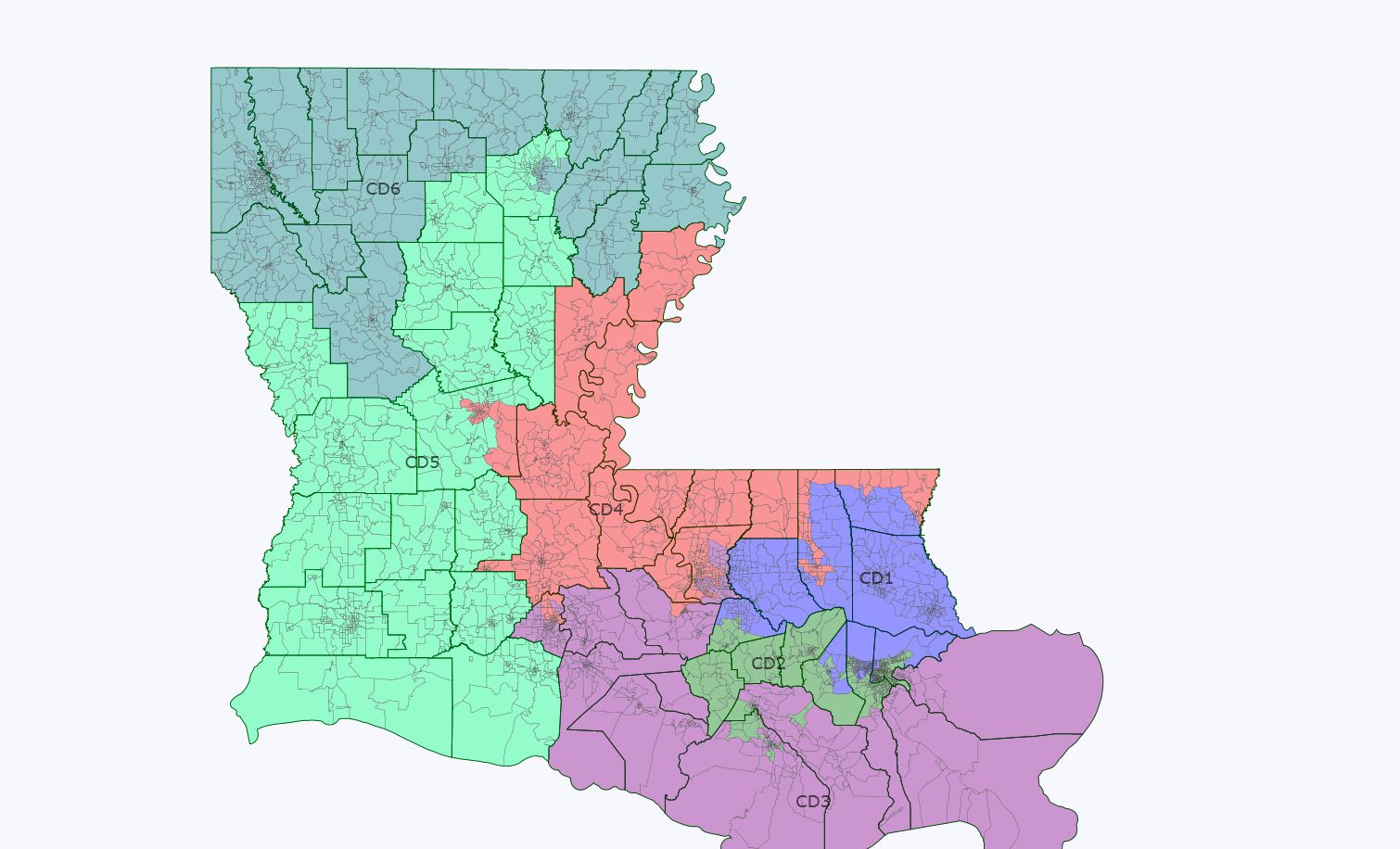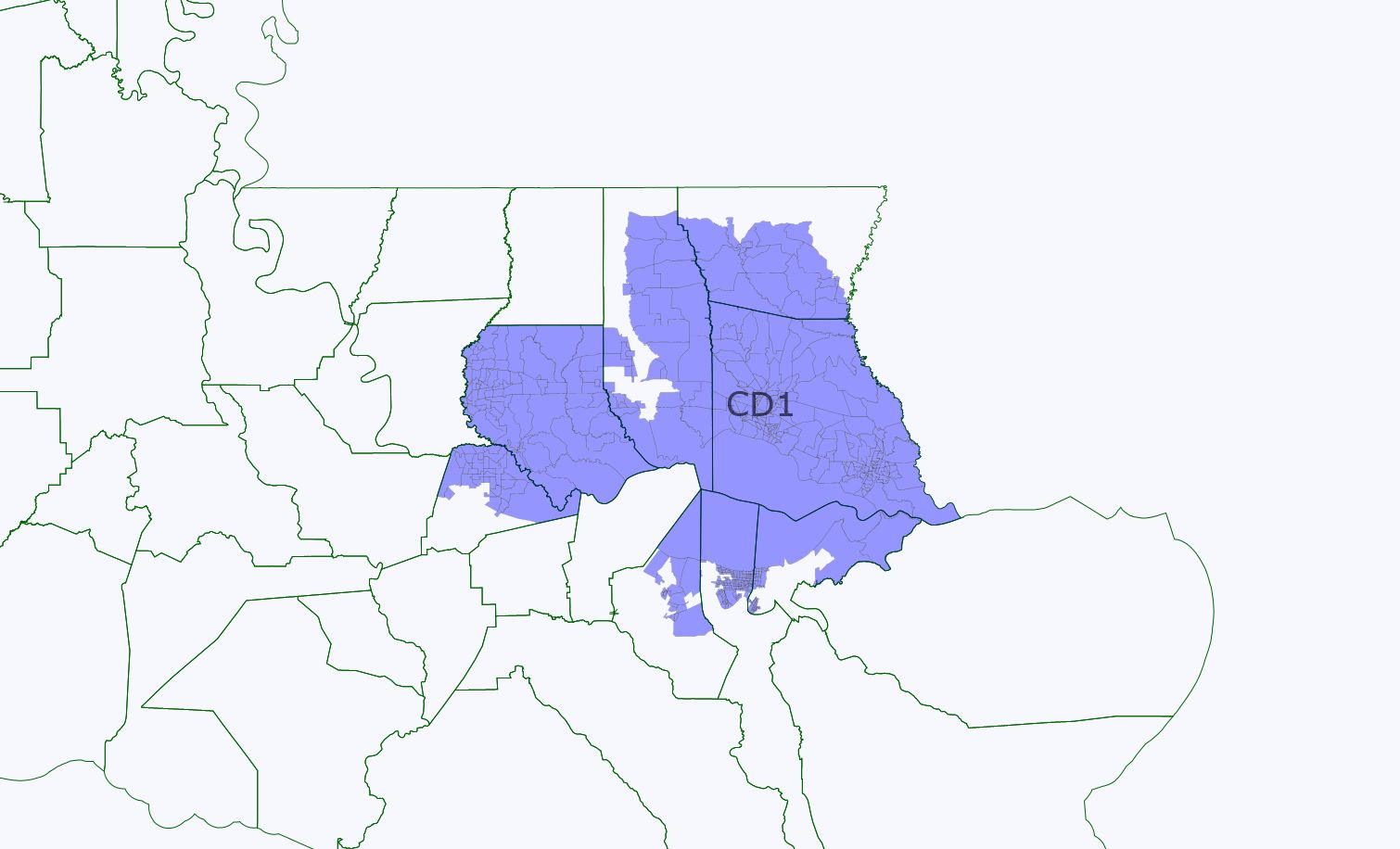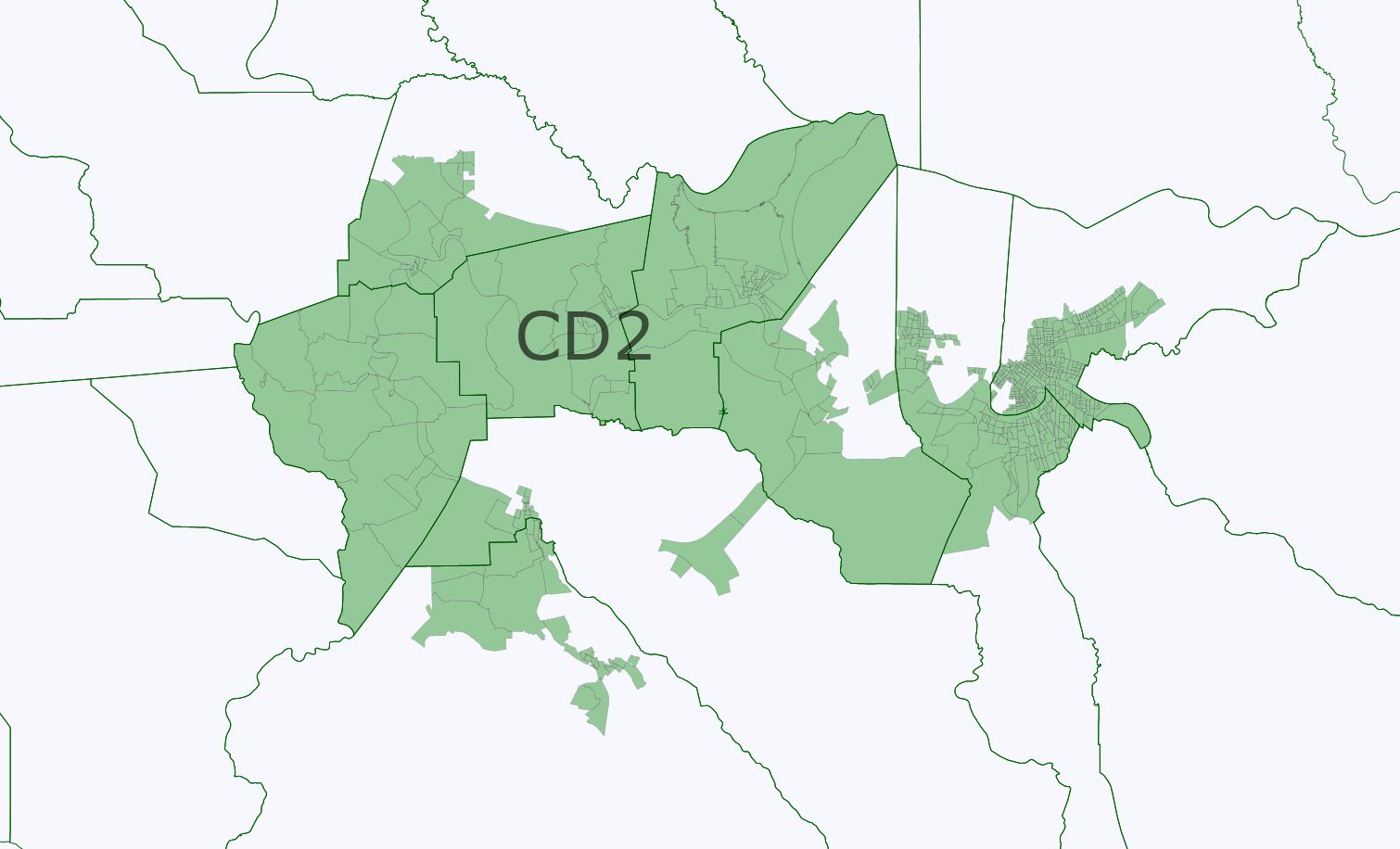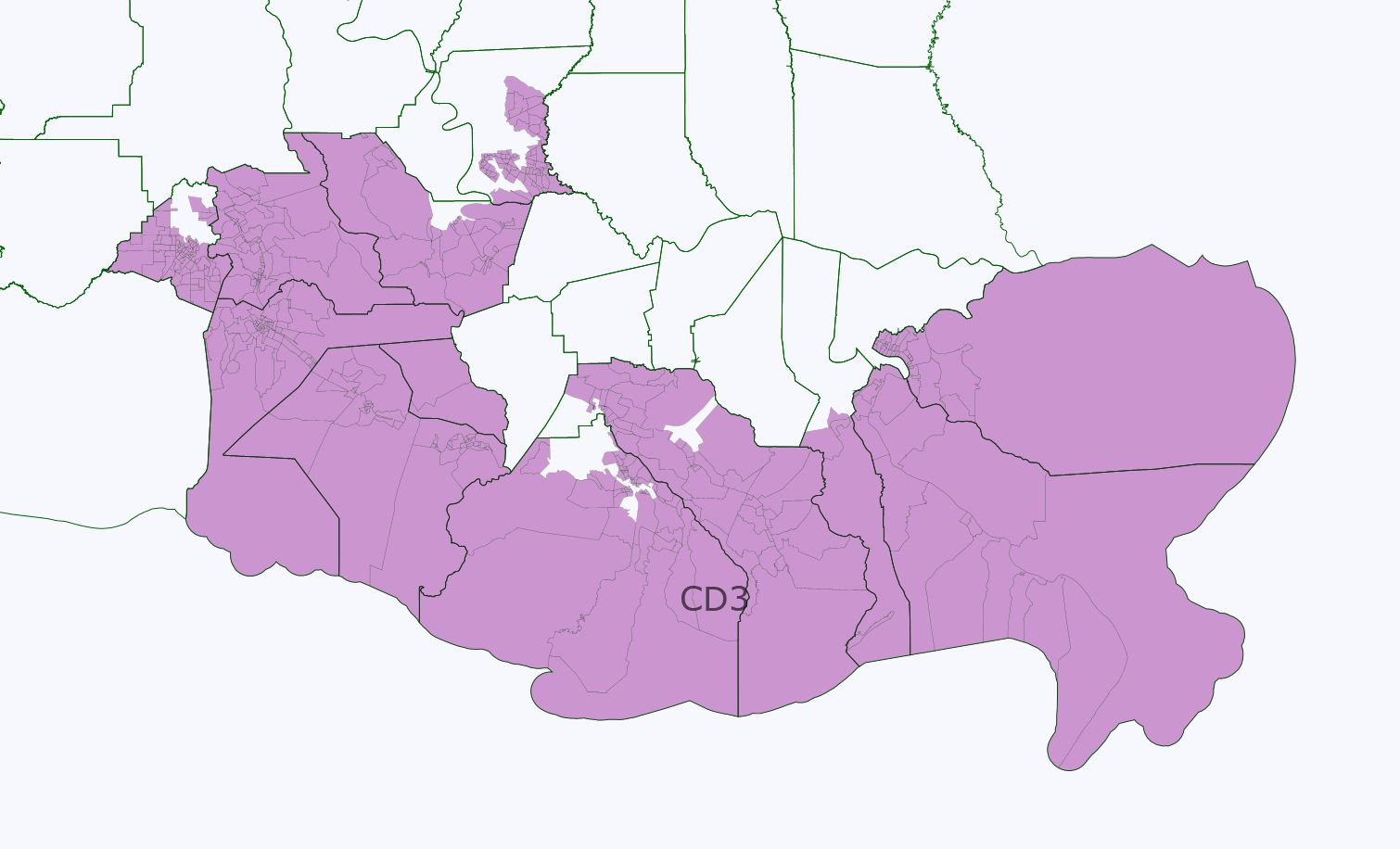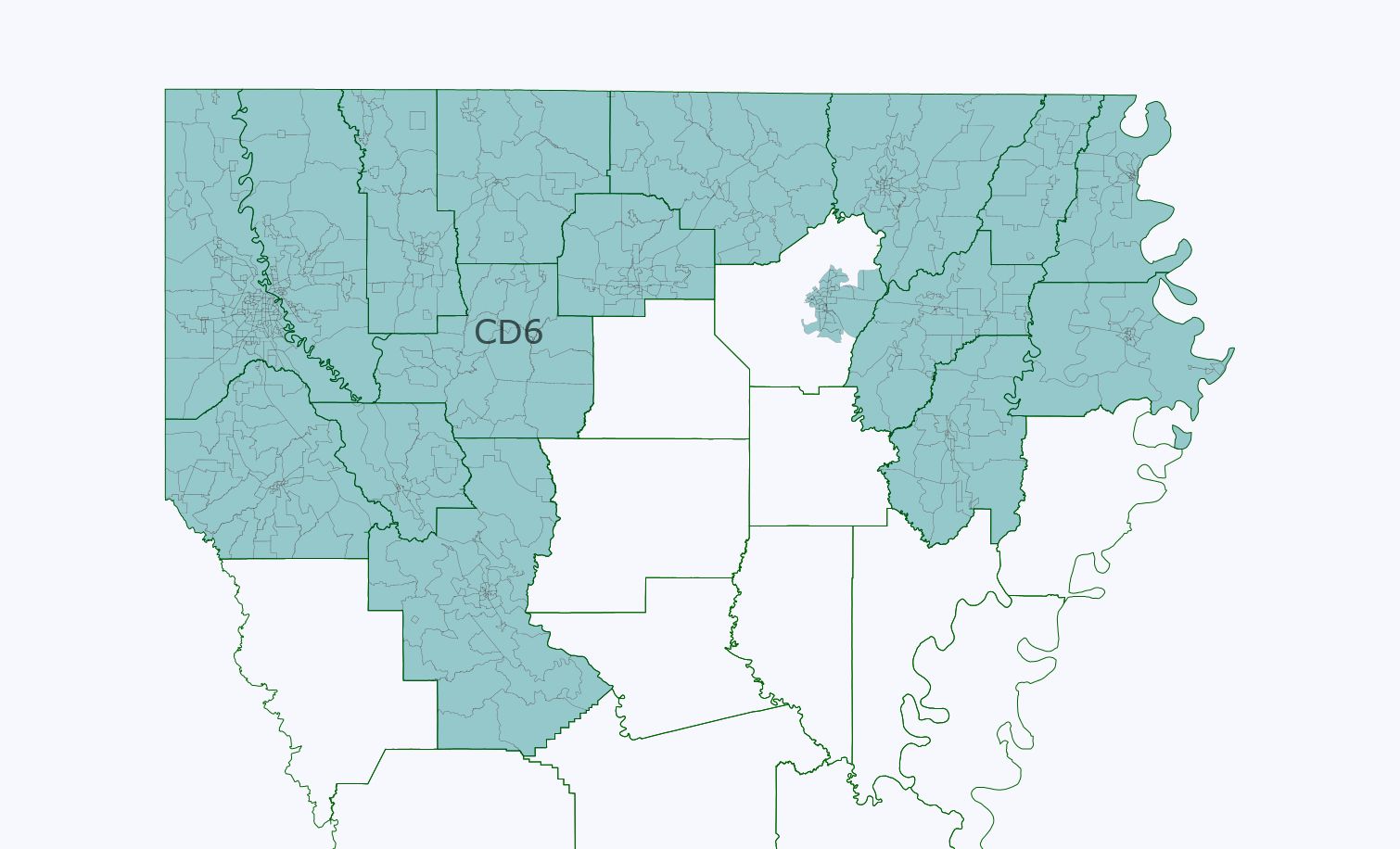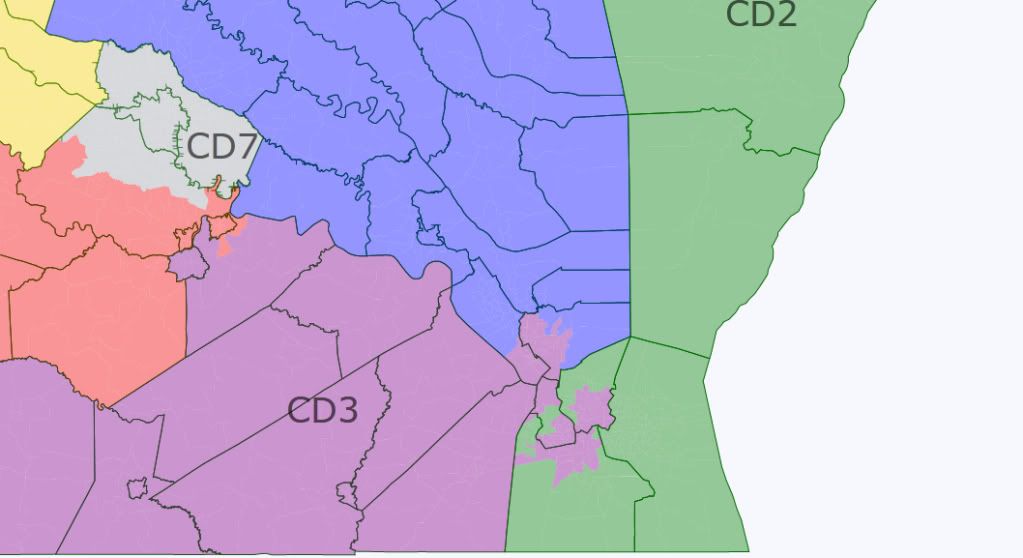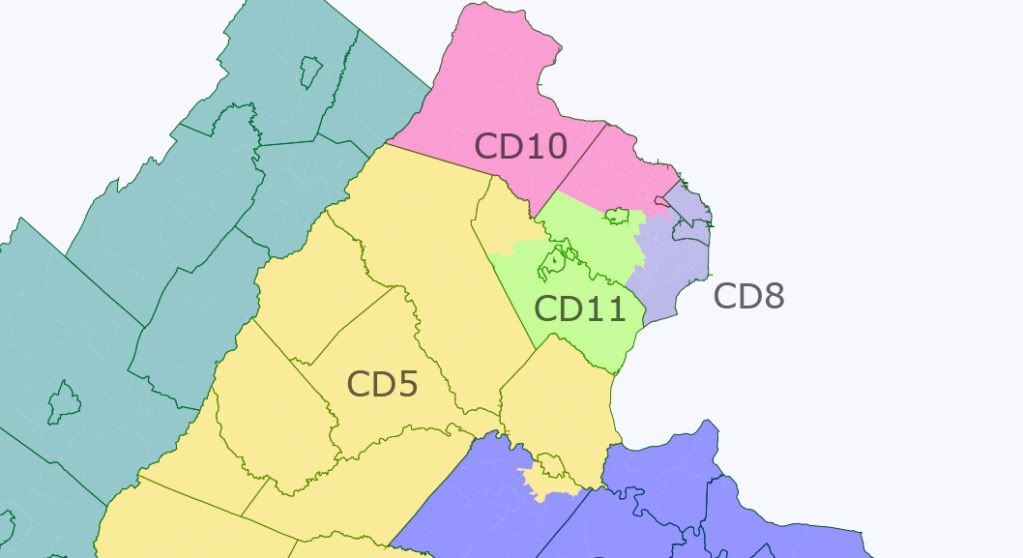Here we go again! Another California map…
I dunno how much demand is actually left for California redistricting maps, but here’s my latest version anyhow. Since this’ll be the last map I post (of California or any other state) until actual Census data is available, I’ve decided to go all out.
When I posted my original California map that basically disregarded the VRA, and again when I posted my VRA maps of Southern states, I was strongly encouraged to create a new California map that takes the VRA as its starting point. While initially somewhat resistant, I was persuaded that I should do exactly that mainly when I looked over the new California redistricting guidelines and saw that they prioritize the VRA above all other criteria.
Moreover, whereas my initial map used the 2008 population estimates, I wanted to make a map using the more accurate American Community Survey projections. So, I’ve created the following maps and analysis by this methodology:
1) I first addressed Section 5 preclearance concerns to ensure that none of the four covered counties (Kings, Merced, Monterrey, Yuba) would be subject to a “retrogression” challenge.
2) I then addressed Section 2 requirements that majority-minority districts be drawn wherever compact minority communities permit the drawing of such districts without substantially ignoring traditional redistricting criteria.
3) I then filled in the rest of the map based on the non-partisan criteria specified by the California guidelines (contiguity, geographic integrity, communities of interest, compactness). As such, I altogether disregarded partisan data and incumbent residency as required by law (especially easy to do on the ACS version at Dave’s app which doesn’t feature partisan data).
4) However, I wanted to know what the partisan effects would be, so I then had to translate my ACS-VRA map into partisan figures – which was easily the most time-consuming part of this exercise.
5) Finally, I was curious to see how the maps I drew would match up with the current incumbents, so I pinpointed where each one lives and identified in which district on my map they would end up.
The resulting maps below feature 37 majority-minority seats of which 15 are majority-Latino and 1 is majority-Asian.
So, I’m finally ready to present all that after the jump. Needless to mention, analyzing California is a daunting task, so I’ve decided to organize my presentation as follows:
For the purposes of my discussion, I’ve divided the state into the following regions: (1) Northern California (including Sacramento); (2) the Bay Area; (3) the Central Valley & Central Coast; (4) Los Angeles; (5) Orange County & the Inland Empire; (6) the San Diego Area.
For each region, I’ve posted some general comments, then listed the 2008 Obama/McCain figures for each district including the incumbent of that currently numbered district, and then posted the relevant maps. I then have three sections of commentary: VRA Implications, Partisan Impact, and Incumbents.
A quick note on the latter: It goes without saying that where the incumbents end up in the new maps is highly speculative. The reason why I decided to look at this anyhow is twofold: (1) at the very least, it gives some sense of how the new maps are likely to scramble the incumbents, even if the actual final arrangement is very different; (2) the places where incumbents are likely to end up together in the same district or where districts are likely to initially end up without a resident incumbent obviously correlate with the most highly gerrymandered parts of the state, and so therefore it’s safe to say that the incumbents that are most affected on my map will be the ones at highest risk under the actual maps. Of course, residency within a district is not a requirement to run for Congress, but Congress critters do generally prefer to run where they live – or to move if they have to.
One last note before I get underway: I’ve played with the California maps enough at this point that I have a rather good sense of what decisions are likely to help Democrats or Republicans. All else being equal, I have generally made those decisions which are most helpful to the GOP. On one hand, I’ve done this to minimize unfounded accusations of partisan mapping bias on my part. On the other hand, I’ve done this because I think similar decisions will maximize the likelihood of a map being approved by the Redistricting Commission which requires three GOP votes to pass the maps. On the third hand (?!), I’ve done this because I would rather see a ‘worst-case scenario’ for Democrats, with the awareness that the actual maps are likely to be somewhat more favorable, than to promote a rose-colored glasses view inconsistent with the probable outcome. In short, if you are a Republican and you don’t like my maps, you probably need to reflect on how consistent your perception of California is with reality.
So, without further ado, here goes!
Below I’ve started with two maps. The first is a broader view of NorCal while the second is a closer view of Sacramento so that it’s clear where I’ve drawn the lines and how the Sacramento districts intersect with the surrounding districts.
In my view, the NorCal mapping scheme is very likely to resemble this arrangement. (I guess that’s stating the obvious..) On one hand, there’s a certain symmetry: two districts anchored by Sacramento, two compact districts extending toward the northwest and the northeast respectively, and one district covering the sparsely populated northern end of the state.
I’ve seen several maps that further subdivide Sacramento County or that create more elongated districts stretching as far as the Oregon border. I personally don’t think the such maps are consistent with the current rules that call for minimizing county/city subdivisions and that generally prohibit bypassing centers of population to reach more distant populations.
In any case, here are the partisan figures for these five districts. I’ll post further comments after the maps.
CA-01 (D-Thompson): 61% Obama – 37% McCain
CA-02 (R-Herger): 47% Obama – 51% McCain
CA-03 (R-Lungren): 50% Obama – 48% McCain
CA-04 (R-McClintock): 44% Obama – 54% McCain
CA-05 (D-Matsui): 68% Obama – 30% McCain (61% Minority – 18% Asian; 25% Latino)


VRA Implications: There’s not much in the way of VRA implications with concern to mapping Northern California. Yuba County is a Section 5 preclearance county but it’s currently in a 76% white district. On my map, it goes from its present location in CA-02 represented by Herger to the CA-04 district represented by McClintock. The new CA-04 district has virtually identical racial/partisan stats as the current CA-02, so there’s no “retrogression” concern. The only other district of VRA interest is CA-05 and my map takes it from 56% minority to 61% minority. There’s no prospect of creating any other majority-minority districts, nor is there a prospect of creating a district with a majority from a single minority group.
Partisan Impact: Herger’s CA-02 district goes from 55% McCain to 51% McCain and Lungren’s CA-03 goes from an even 49%-49% split to 50% Obama/48% McCain. In the case of CA-02, the district should be safe enough for Herger, but he’d probably have to actually put a bit of effort into his reelection campaigns and there might be an opening for the right Democrat in a good year for Dems, particularly if the seat comes open.
Lungren’s CA-03 might be far more problematic from his standpoint. On paper, it’s a ‘tossup’ at worse, but Lungren’s been facing stiff challenges in recent elections, and he doesn’t strike me as a particularly good fit for this district that’s now fully contained in Sacramento County. While the district should be quite suitable for a Sacramento Republican, I’m not too sure that Lungren is that Republican, and the area is gradually trending leftward (which will be a problem for the GOP no matter how the ‘second’ Sacramento district gets drawn).
The other three districts are not meaningfully affected, though Thompson’s CA-01 does drop from 66% Obama to 61% Obama.
Incumbents: My map doesn’t displace any of the current incumbents in these five districts and it’s unlikely that any mapping scheme would. That includes Tom McClintock: A lot of sources still list his residence as Elk Grove in Sacramento County, but he’s officially moved to Roseville in Placer County.
My latest map of the Bay Area is below.
The most consequential effect of using the ACS figures has been that CA-11 is clearly pushed out of the Bay Area and into the Central Valley (which is where I’ll deal with it below). Otherwise, my main concerns here were maximizing the number of majority-minority seats and carving out a majority-Asian seat in particular.
In my experimentation with mapping the Bay Area, it seems fairly clear to me that there are only two districts with significant ambiguity as to how the lines will end up: On my map below, they’re CA-10 and CA-16. What does seem clear enough, however, is that most of the districts will be arranged along the Bay coast, with a ‘hinterland’ district centered in Contra Costa/Alameda, and then leaving what I think of as a ‘mop-up’ district piecing together the ‘leftovers’ from the districts with more obvious placement (e.g., CA-10 on this map).
It’s also worth noting that the contours of this mapping scheme were partially determined by what has to happen in the Central Valley to maintain a VRA-compliant CA-18 district. To do that, you have to split off the heavily Latino parts of Stanislaus and San Joaquin counties, which means you have to situate a district on the remainder which still leaves a part left over on one end or the other. The most coherent mapping scheme I could identify involved attaching that leftover part to CA-10 rather than, say, CA-19. Either way, it doesn’t make much difference: CA-10 will still be heavily Dem and CA-19 will still be heavily GOP.
CA-06 (D-Woolsey): 76% Obama – 22% McCain
CA-07 (D-Miller): 73% Obama – 25% McCain (52% Minority – 15% Asian; 24% Latino)
CA-08 (D-Pelosi): 85% Obama – 13% McCain (52% Minority – 29% Asian)
CA-09 (D-Lee): 88% Obama – 10% McCain (64% Minority – 20% AA; 20% Asian; 21% Latino)
CA-10 (D-Garamendi): 61% Obama – 38% McCain (55% Minority – 24% Latino)
CA-12 (D-Speier): 74% Obama – 25% McCain(57% Minority – 32% Asian; 19% Latino)
CA-13 (D-Stark): 70% Obama – 28% McCain (74% Minority – 51% Asian)
CA-14 (D-Eshoo): 71% Obama – 27% McCain
CA-15 (D-Honda): 71% Obama – 27% McCain (71% Minority – 26% Asian; 39% Latino)
CA-16 (D-Lofgren): 65% Obama – 34% McCain (52% Minority – 17% Asian; 25% Latino)

VRA Implications: My map takes the Bay Area from seven majority-minority districts out of 11 to eight majority-minority districts out of 10. The CA-13 district is also majority-Asian. In some cases, I’ve swapped proportions (i.e., CA-08 goes from 58% to 52% minority while CA-12 goes from 52% to 57% minority; CA-16 goes from 69% to 52% minority while CA-15 goes from 53% to 71% minority). This is augmented by the fact that CA-11 goes from the current 63% white district to a 52% minority district in the Central Valley and CA-17 on the Central Coast becomes a majority-minority district.
For the record, you evidently cannot create a majority-Latino district in San Jose even if you ‘give up’ the majority-Asian district. The Latino population is too intermixed with the Asian population in much of the area.
Partisan Impact: The Bay Area seats will all be heavily Democratic seats no matter how they’re mapped out.
It’s been suggested elsewhere that ‘a foothills seat in Contra Costa / Alameda’ could be a tossup seat. This is obviously not true – mainly because you don’t have anywhere near enough people there as should be self-evident in these maps. The most Republican seat that I was able to create following that guideline was a 59% Obama seat. Once you take in all the most Republican areas in the eastern part of the Bay counties, you must necessarily go into heavily Democratic areas in order to fill out the necessary population.
There’s also been a suggestion that: “The outer areas of current CD14-CD15-CD16 could end up being a tossup seat.” That makes no sense whatsoever. The “outer areas” of those districts are basically Santa Cruz County, which was a 77% Obama county. To make the long story short, anyone who sees a “tossup” district in the Bay Area (much less a Republican district) is hallucinating.
Incumbents: My mapping scheme would inconvenience several Bay Area incumbents, with at least one of them being out of a job (unless he or she moves to the Central Valley). McNerney lives in Pleasanton (central Alameda County) which ends up in CA-16 on this map. Since this district is most similar to his current district, I think he’d be very likely to run there. Mike Honda lives in the Campbell area of San Jose, which ends up in CA-14 on this map. This is essentially Anna Eshoo’s district who lives in Atherton which is still in CA-14. Meanwhile, Zoe Lofgren lives in San Jose and would end up in CA-15.
As I see it, the most obvious place for Mike Honda to run would actually be CA-13 since it becomes majority-Asian and takes in substantial parts of his current district, but if Pete Stark doesn’t retire that’d mean a primary battle – aside from the residency issue. Ultimately, I don’t know how this would be sorted out. Perhaps some Californians could comment on it.
Whatever the case, tidying up the lines in the San Jose area makes it highly probable that at least two Democrats will end up in the same district – even leaving aside the fact that the Bay Area will lose a seat.
It’s also worth noting that Garamendi lives in Walnut Grove (Sacramento County) which just barely ends up in this CA-10 district. That said, I think Garamendi will end up running in whatever district most resembles his current district regardless, whether or not he has to move.
The Central Coast and the Central Valley are really two separate regions, but I’ve decided to cover them together for the sake of expedience. By and large, the mapping scheme that I settled on was dictated by Section 5 preclearance concerns, since three of these counties are covered: Kings, Merced, and Monterey. In short, I mapped the relevant districts first (CA-20, CA-18, and CA-17) to satisfy ‘retrogression’ concerns, and then mapped the rest accordingly.
A couple of general points are worth noting. San Benito County only has about 55,000 people and doesn’t really make a significant difference regardless how it’s mapped. I basically chose to add just enough of it to CA-17 so that the boundaries with CA-12 to the north and CA-23 to the south could be the coastal county lines. The remainder then obviously belonged with CA-20 (but again, it makes no meaningful difference to either the partisan or ethnic breakdown).
As for the Great Basin, it’s even more sparsely populated and even less consequential than San Benito. I’m sure there’s some Republican out there who imagines that if the Great Basin were instead divided and appended to the more central districts it’d somehow benefit the GOP. Any such Republicans are misguided. About 30,000 people live in the Great Basin and chopping it up does little besides create a less coherent map. But, hey, if it makes the Commission feel better for some reason, I say go for it.
Besides reiterating that CA-11 isn’t really ‘McNerney’s district’ on this map – having been displaced from the Bay Area to the Central Valley due to population shifts – I’ll save the rest of my commentary for below.
Here’s the Obama/McCain breakdown for these districts:
Central Coast
CA-17 (D-Farr): 73% Obama – 25% McCain (54% Minority – 44% Latino)
CA-23 (D-Capps): 57% Obama – 41% McCain
CA-24 (R-Gallegly): 56% Obama – 43% McCain (52% Minority – 41% Latino)
Central Valley
CA-11 (D-McNerney): 51% Obama – 47% McCain (52% Minority – 33% Latino)
CA-18 (D-Cardoza): 57% Obama – 41% McCain (69% Minority – 54% Latino)
CA-19 (R-Denham): 41% Obama – 56% McCain
CA-20 (D-Costa): 50% Obama – 48% McCain (75% Minority – 66% Latino)
CA-21 (R-Nunes): 51% Obama – 47% McCain (62% Minority – 42% Latino)
CA-22 (R-McCarthy): 39% Obama – 59% McCain (54% Minority – 42% Latino)


VRA Implications: The VRA implications are quite significant in that three of the four California counties that require Section 5 preclearance are in this central region. Here’s how I’ve handled each in turn:
Merced County goes from a 42% Latino plurality in the current CA-18 district to a 54% Latino majority on my map. Clearly this more than satisfies Section 5 requirements.
Monterey County goes from the current 50% white/39% Latino CA-17 district to a 46% white/44% Latino district on my map. This is about as Latino as this district will get absent extreme gerrymandering, and it certainly cannot be challenged on ‘retrogression’ grounds.
I’m far more ambivalent about the CA-20 district that I’ve drawn which includes Kings County. On the one hand, it goes from 63% Latino to 66% Latino according to the ACS figures. On the other hand, it drops from a 60% Obama district to a 50% Obama district. This is mainly because it trades heavily Democratic parts of Fresno and Bakersfield with settled Latino communities for rural areas where the Latino population is more comprised of often-transient agricultural workers. In short, the CA-20 district that I’ve drawn may not be deemed as providing Latinos with a true opportunity to elect a “candidate of choice” despite the high Latino percentage. Even more importantly, it may be the case that Latino registration figures are so out of sync with the Census count that this district would still be considered ‘retrogressive’ under Section 5.
To make the long story short, if this district fails to satisfy Section 5 requirements, then obviously the solution is to restore the current dip down to Bakersfield, and the district will obviously become much more Democratic. On the flip-side, I decided to roll with the district I mapped out because that may well be the kind of district that will satisfy the GOP enough to garner three Republican votes for passage by the Commission.
Aside from these Section 5 issues, my map features seven majority-minority districts where there are currently four, and two of these are majority-Latino versus just one on the current map.
Partisan Impact: For the Central Coast the partisan impact is virtually assured: CA-17 remains heavily Democratic, CA-23 becomes somewhat more competitve but still likely Democratic, and CA-24 gets a clear Democratic lean. I’ve seen it mentioned elsewhere that – in maps similar to mine – CA-30 somehow crosses over to take in the more Republican parts of Ventura County as a “political” move to favor Democrats, but this is total nonsense. The parts of Ventura County closer to the LA County border are more Democratic, not less Democratic, and if you instead map CA-24 starting at the LA County line northward you end up with a CA-24 district that’s between 58% to 60% Obama.
For the Central Valley, the partisan effect is even more consequential. My map creates a ‘toss-up’ CA-11 district in San Joaquin & Stanislaus, with perhaps a slight GOP lean, in place of a strongly Democratic seat in the Bay Area. Otherwise, CA-20 and CA-21 also become ‘toss-ups’ with a slight GOP lean. The consequences for 2012 are probably more contingent on where the incumbents decide to run, so I’ll comment further below.
Incumbents: None of the Central Coast incumbents are displaced, though Gallegly might as well be.
As for the Central Valley, we can safely say that McCarthy will end up in whatever district covers the bulk of Kern County. Since it strikes me as implausible that one of the Bay Area Democrats or one of the dispossesed SoCal Republicans would move to the Central Valley, that leaves four incumbents for five districts. The question then is where will they run.
In my mapping scheme above, Cardoza would obviously run in CA-18. Denham would also be in CA-18 (both Cardoza and Denham live in Atwater in Merced County), but that’s the case already and it obviously didn’t stop him from running in the current CA-19 district. That said, on my map Nunes (Visalia) is actually in CA-19 and he would represent more of the new district’s population than would Denham. So, I imagine Nunes would likely end up running there. As for Costa, he lives in Fresno and I think he’d almost surely run in CA-21 unless the new CA-20 district ends up being more like the current CA-20 district.
So, that leaves Denham to run in one of the slight-GOP ‘toss-ups’ (CA-11 or CA-20) leaving the other one vacant.
My latest map of Los Angeles is below. There isn’t really that much to say about Los Angeles in general, other than to note that Dreier’s CA-26 district is effectively gone to the Inland Empire (and I’ll discuss it there). Besides that, my goal was, yet again, to create as many majority-minority seats as possible, and to make as many of them as reasonable majority-Latino.
It’s also worth explaining why I chose to have three districts cross over from neighboring counties.
Bringing the CA-42 district across from San Bernardino is the best way to maximize the Latino population of that district while also maintaining the Latino proportion of CA-43. If the goal is to maximize majority-Latino districts, then this is obviously the way to go.
As for CA-40 and CA-46, bringing them into LA County to take in the more white parts of Long Beach (CA-46) and the Whittier/Diamond Bar area (CA-40) is the most effective way to maximize the minority percentage of the neighboring LA County seats, while also maximizing the minority percentages of CA-47 and CA-48 in Orange County. So, from a VRA standpoint, this is again the obvious way to go. From a partisan standpoint it makes no difference of consequence.
Anyhow, here are the districts:
CA-25 (R-McKeon): 50% Obama – 48% McCain (53% Minority – 34% Latino)
CA-27 (D-Sherman): 69% Obama – 29% McCain (76% Minority – 60% Latino)
CA-28 (D-Berman): 71% Obama – 27% McCain (53% Minority – 38% Latino)
CA-29 (D-Schiff): 68% Obama – 30% McCain (69% Minority – 22% Asian; 39% Latino)
CA-30 (D-Waxman): 67% Obama – 32% McCain
CA-31 (D-Becerra): 81% Obama – 17% McCain (82% Minority – 62% Latino)
CA-32 (D-Chu): 63% Obama – 35% McCain (82% Minority – 28% Asian; 52% Latino)
CA-33 (D-Bass): 84% Obama – 14% McCain (79% Minority – 54% Latino)
CA-34 (D-Roybal-Allard): 70% Obama – 28% McCain (82% Minority – 67% Latino)
CA-35 (D-Waters): 88% Obama – 10% McCain (92% Minority – 40% AA; 45% Latino)
CA-36 (D-Harman): 63% Obama – 35% McCain
CA-37 (D-Richardson): 80% Obama – 19% McCain (89% Minority – 56% Latino)
CA-38 (D-Napolitano): 64% Obama – 34% McCain (71% Minority – 60% Latino)
CA-39 (D-Sanchez): 64% Obama – 34% McCain (84% Minority – 67% Latino)

VRA Implications: My map features 12 majority-minority seats in LA County which is the same as the current map. However, the Dreier seat which is currently majority-white has been pushed entirely out of LA County to become a majority-Latino Inland Empire seat. On the flip-side, CA-36 (Harmon) has dropped from 54% minority to 43% minority – which is an unavoidable consequence of eliminating the CA-46 coastal strip to take in Palos Verdes. Meanwhile, McKeon’s CA-25 seat has gone from 43% minority to 53% majority-minority. So, to make the long story short, this represents a net gain of one majority-minority seat.
The other significant VRA development is that my map features 8 majority-Latino seats versus 6 in the current map. The current majority-Latino seats have these Latino percentages: 77%, 70%, 69%, 62%, 61%, 55%. My Latino-majority seats have these percentages: 67%, 67%, 62%, 60%, 60%, 56%, 54%, 52%. In short, I’ve chosen the best balance I could come up with between maintaining the population of the current majority-Latino seats versus creating new ones. If the Commission would prefer one or two more seats above 65% then they’ll just create choppier lines. If so, more power to them; I don’t see the need to do so.
Partisan Impact: There’s really not much to say here. LA County will feature 13 heavily Dem seats and one McKeon seat. The Dreier seat, of which a majority lives outside LA County anyhow, will surely be displaced. The CA-25 McKeon seat that I’ve drawn here is basically the most Republican leaning seat that can be drawn in the less-populated northern half of LA County. If it dips south anywhere besides the places where I’ve chosen then the Obama percentage will rise.
Beyond that, there is of course no possibility of a second GOP seat in LA County. However, I do want to comment on what seems to be a widespread misconception that a more GOP leaning CA-36 might be drawn if it were oriented eastward (from Palos Verdes to Long Beach) rather than northward (from Palos Verdes to Santa Monica). In reality, this is simply not true and the only reason why I can figure this mistaken belief has seemingly become common on SSP is because it keeps getting repeated in every California thread despite having no support whatsoever. In actuality, the CA-36 district that I’ve drawn here is the most Republican seat that can viably be drawn in southwest LA, and everything around it is heavily Democratic. The more you shift it toward Long Beach, the more Democratic it becomes.
Incumbents: Perhaps the most interesting part of my LA map is in how it scrambles the incumbents, which I imagine is very likely to be the case with any LA mapping scheme that is less gerrymandered than the current one. Needless to mention, this is only representative of what might happen, but here’s the list of LA districts with who currently represents the district of that number and with where the incumbents end up on my map:
CA-25 (R-McKeon): McKeon (Santa Clarita)
CA-27 (D-Sherman): Vacant
CA-28 (D-Berman): Sherman (Sherman Oaks); Berman (Valley Village); Schiff (Burbank)
CA-29 (D-Schiff): Becerra (Eagle Rock)
CA-30 (D-Waxman): Waxman (Beverly Hills)
CA-31 (D-Becerra): Roybal-Allard (Boyle Heights)
CA-32 (D-Chu): Chu (Monterey Park)
CA-33 (D-Bass): Bass (Culver City); Waters (Hancock Park)
CA-34 (D-Roybal-Allard): Linda Sanchez (Lakewood)
CA-35 (D-Waters): Vacant
CA-36 (D-Harman): Harman (Venice)
CA-37 (D-Richardson): Richardson (Long Beach)
CA-38 (D-Napolitano): Dreier (San Dimas)
CA-39 (D-Sanchez): Napolitano (Norwalk)
How they’d sort it all out is obviously speculative at best, but I do want to make a few observations.
Waters does not live in the current CA-35 district anyhow, so I doubt this makes any difference in that regard. I don’t know if she maintains a property or whatever in Watts, but her current arrangement would obviously work just as well no matter how the new maps are drawn.
Berman and Sherman live very close together and it took some creative map-drawing to keep them in separate districts in 2001. The likelihood of them ending up in the same district is high, especially if the San Fernando Valley is consolidated into a 60%+ majority-Latino district, as seems quite likely.
It doesn’t really matter where Dreier ends up, since he won’t be able to win an LA County district regardless (unless he moves to CA-25), so I presume that if he does end up as the only resident incumbent of a district then one of the Democrats will move over to help sort things out.
Finally, Harman doesn’t actually matter anymore for these purposes. So, it’s worth noting that of the two contenders for the CA-36 seat, Debra Bowen lives in Marina del Rey and would still be in CA-36 on my map. Janice Hahn lives in San Pedro near the Port of Los Angeles which ends up in CA-37 on this map. Since the lower part of CA-36 will almost surely have to shift westward to take in Palos Verdes, it’ll be a very close call which side of the line San Pedro ends up on.
If you’re a Winograd supporter, get real. (She lives in Marina del Rey.)
The next two maps cover Orange County and the Inland Empire. In my mapping scheme, this also includes CA-26, which is now a Riverside County seat. It’s worth noting that, although CA-26 is more commonly thought of as an LA County seat, a majority of the current CA-26 population actually lives outside LA County. Since the seat anchored by Riverside city is the least congruent with any of the current districts, it makes sense to label that CA-26 for comparative purposes.
My mapping scheme is very straightforward, so there’s not really much to add that I don’t cover below. Since the numbering ends up out of order, here’s how these seats break down by county:
San Bernardino
CA-41 (R-Lewis): 44% Obama – 54% McCain
CA-42 (R-Miller): 55% Obama – 43% McCain (71% Minority – 54% Latino)
CA-43 (D-Baca): 65% Obama – 33% McCain (79% Minority – 61% Latino)
Riverside
CA-26 (R-Dreier): 59% Obama – 39% McCain (70% Minority – 53% Latino)
CA-44 (R-Calvert): 41% Obama – 57% McCain
CA-45 (R-Bono Mack): 50% Obama – 48% McCain (52% Minority – 43% Latino)
Orange
CA-40 (R-Royce): 44% Obama – 54% McCain
CA-46 (R-Rohrabacher): 50% Obama – 48% McCain (52% Minority – 22% Asian; 25% Latino)
CA-47 (D-Sanchez): 56% Obama – 42% McCain (77% Minority – 61% Latino)
CA-48 (R-Campbell): 53% Obama – 45% McCain (59% Minority – 37% Latino)


VRA Implications: On the current map, these 10 seats include only 3 minority-majority seats (CA-40, CA-43, CA-47) two of which are also majority-Latino (CA-43 & CA-47). My map has 7 out of 10 seats as majority-minority and 4 of these are majority-Latino. It’s difficult to envision a more drastic improvement from a VRA standpoint.
Of the current majority-Latino seats, I’ve nudged Baca’s CA-43 up from 58% Latino to 61% Latino. Loretta Sanchez’s CA-47 has dipped from 65% Latino to 61% Latino. I should say that I was somewhat ambivalent about this latter move, but it’s a necessary tradeoff if CA-48 is to become a solid majority-minority seat in its own right. More importantly, I suspect that the actual Census figures will make it quite easy to turn CA-48 into a majority-minority Irvine-based seat alongside an Anaheim-based CA-47 district with a Latino percentage about where it’s at now.
Otherwise, there seems little doubt that three compact majority-Latino seats can be anchored in San Bernardino, Chino, and Riverside. Beyond that, pulling CA-46 out of Palos Verdes virtually assures that it becomes majority-minority – even if only slightly so – and CA-45 is probably even more Latino than the ACS figures project.
Finally, it’s also worth noting that CA-40 and CA-41 are each 51% white on this ACS map, so they may actually be majority-minority in the Census count.
Partisan Impact: The partisan impact for the Inland Empire is perhaps the most substantial aside from the Central Valley. The new Riverside seat is virtually assured to be strongly Dem – and basically replaces the current heavily-gerrymandered Dreier seat. Meanwhile, Gary Miller’s seat goes from a 53% McCain district to a 55% Obama district.
In Orange County, the most significant impact is on Campbell who goes from a 49%O-49%M district to a 53% Obama district. Rohrabacher’s seat becomes just slightly less secure on my map (going from 48%O/50%M to 50%O/48%M) but it’s worth noting that if CA-46 were to take in any more of Long Beach, or if it took in the part of LA County running more along the county border rather than along the Long Beach coastline, then it would become steadily more Democratic.
On the flip-side, CA-40 and CA-44 both become more solidly GOP as white voters get packed here to make way for the majority-minority seats. CA-44 in particular goes from a 50% Obama district to a 57% McCain district.
Incumbents: Several incumbents get displaced by this mapping scheme. Gary Miller lives in Diamond Bar which ends up in the CA-40 district. This would probably be just as well because if something like these maps were the case then it makes far more sense for Miller to challenge Royce (Fullerton) in a primary than to run in the CA-42 district. If CA-40 doesn’t enter LA County, then I think the most likely alternative is for Miller to end up in one of the ultra-Dem LA County districts, so my map is probably about the best-case scenario for him.
This map also draws Lewis (Redlands) and Baca (Rialto) into the same CA-43 district, but I’m sure Lewis could easily run in CA-41 regardless (and he’s reportedly considering retirement anyhow). Finally, Calvert lives in Corona which ends up in CA-42 here, but I’m sure he’d run in the CA-44 district (or its equivalent) no matter where he ends up.
Below I’ve included two maps. The first is a broader view of SoCal while the second is a closer view of San Diego so that it’s clear exactly where I’ve drawn the lines.
In my view, this mapping scheme is the most likely arrangement for San Diego County. The city and suburbs of San Diego can clearly anchor two compact seats, and most people seem to agree that Imperial County is most ‘naturally’ attached to San Diego County versus Riverside County. Once those decisions are made, then the rest seems obvious: maximize Latino percentage in CA-51, turn CA-52 into a majority-minority district, and then place CA-50 & CA-49 northward along the coast.
That said, I realize that there’s a contingent that favors an Imperial to Riverside mapping scheme instead, so I’ve actually decided to create an alternative map on that basis. For the sake of keeping things clear, and since the main body of this diary is long enough as it is, I’ll post that separately in the comments.
For now, here are the partisan figures for the five San Diego County districts. Once again, I’ll post further comments after the maps.
CA-49 (R-Issa): 47% Obama – 51% McCain
CA-50 (R-Bilbray): 50% Obama – 49% McCain
CA-51 (D-Filner): 57% Obama – 42% McCain (76% Minority – 61% Latino)
CA-52 (R-Hunter): 54% Obama – 44% McCain (55% Minority – 32% Latino)
CA-53 (D-Davis): 63% Obama – 36% McCain


VRA Implications: The main VRA implications are that I’ve pushed the Latino percentage of CA-51 from 53% to above 60% and I’ve turned CA-52 into a majority-minority district. I chose CA-52 instead of CA-53 because, much to my surprise, when I looked at what remained after I pushed CA-51 to 60% Latino it was clear that CA-52 could much more easily become majority-minority than could CA-53. When I tried doing it with CA-53 instead, I ended up with far more weirdly shaped districts. That said, we can’t rule out the possibility that the actual Census figures will make CA-53 the more viable majority-minority district.
It’s also worth noting that CA-52 was already a 52% Obama district when I initially mapped it based on geographic cohesion without regard to minority percentage. The ‘VRA modification’ just bumped it up, obviously.
Partisan Impact: The main partisan consequence of this mapping scheme is to turn CA-52 from a 53% McCain district to a 54% Obama district.
This is what it comes down to for San Diego, as I see things: CA-51 and CA-53 will be safe Dem no matter what. (I’ve seen a fantasy floating around that pushing up the minority percentage of CA-51 might somehow endanger Susan Davis. This is clearly false. The heavily Dem western parts of San Diego city will anchor a Democratic district no matter what happens with CA-51.) Now, it might well turn out that Filner is subject to a strong Latino primary challenge (assuming he doesn’t run for mayor of San Diego), but that won’t matter in partisan terms.
On the flip-side, CA-49 and CA-50 are likely to remain GOP leaning much as they are now (they each become a bit less GOP on my map, but should still be expected to elect Republicans for the time-being, and certainly to re-elect the current incumbents).
The only real question is what happens with CA-52. In short, the more compact CA-52 becomes the more Democratic it becomes. Since the California guidelines mandate compactness except where VRA requirements suggest otherwise, and especially since a more compact CA-52 district in the eastern suburbs of San Diego city can be made majority-minority (which is not the case if a district similar to the current CA-52 in the San Diego County hinterland were maintained) then I think this is the more likely outcome.
Incumbents: Issa and Bilbray live just 8 miles away from each other, in Vista and Carlsbad respectively, so it’s quite likely they’ll end up mapped in the same district. My map happens to put them both in CA-49 (while my alternative Imperial-to-Riverside map happens to put them both in CA-50). The short of it is that one or the other will very likely have to move or else run in a district where he no longer resides. The other three incumbents are very unlikely to be displaced.
